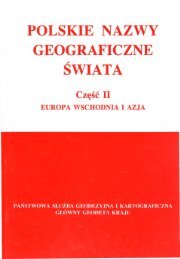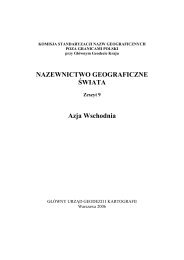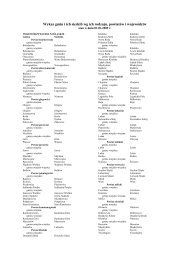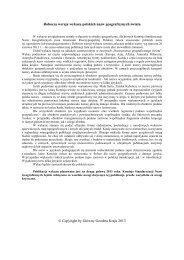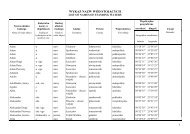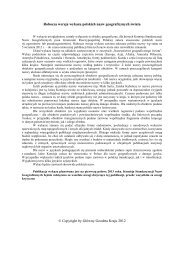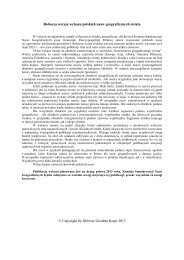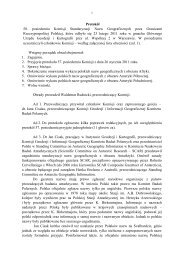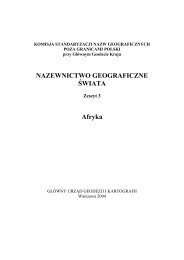Pobierz publikacjÄ - KSNG Nazwy geograficzne - GÅówny UrzÄ d ...
Pobierz publikacjÄ - KSNG Nazwy geograficzne - GÅówny UrzÄ d ...
Pobierz publikacjÄ - KSNG Nazwy geograficzne - GÅówny UrzÄ d ...
You also want an ePaper? Increase the reach of your titles
YUMPU automatically turns print PDFs into web optimized ePapers that Google loves.
as a language of literature until the 20 th century. At present<br />
it is an official language of Belarus. Belarusians use the<br />
Cyrillic alphabet, which was created to Christianize the<br />
Slavic People in the 9 th century. The modern Belarusian<br />
alphabet includes a special character ў, which is not used<br />
in other Cyrillic alphabets and letter i. In 2000, Belarus<br />
submitted a national romanization (transliteration) system<br />
to the UN. In Poland, the transcription of the Belarusian<br />
forms has had a few centuries long tradition; transcription<br />
tables are part of orthographic dictionaries of the Polish<br />
language.<br />
The most characteristic feature of the Belarusian phonetics<br />
refers to affricates [|,] and [ƒ,], which derive from<br />
old [t,] and [d,], as well as to pronouncing unstressed e and<br />
o as a. These features are mirrored in the Belarusian spelling<br />
which is similar to modern pronunciation.<br />
5.2. The Kashubian language<br />
wieku. Obecnie jest językiem urzędowym na Białorusi.<br />
Białorusini używają alfabetu cyrylickiego, który powstał<br />
na potrzeby chrystianizacji Słowian w IX wieku. Współczesny<br />
alfabet białoruski zawiera specyficzny znak ў, nieznany<br />
innym alfabetom cyrylickim oraz literę i. W 2000 r.<br />
Białoruś zgłosiła do ONZ narodowy system latynizacji<br />
(transliteracji). W Polsce transkrypcja form białoruskich<br />
ma kilkuwiekową tradycję; tablice transkrypcyjne podane<br />
są w słownikach ortograficznych języka polskiego.<br />
Za najbardziej charakterystyczną cechę białoruskiej fonetyki<br />
uchodzą spółgłoski zwarto-szczelinowe [|,], [ƒ,],<br />
pochodzące z dawnych [t,], [d,] a także wymowa nieakcentowanych<br />
e, o jako a. Cechy te znajdują odbicie w białoruskiej<br />
pisowni, która jest zbliżona do współczesnej wymowy.<br />
5.2. Język kaszubski<br />
The Kashubian language has been treated as a separate<br />
literary language only for several years (after compiling<br />
prescriptive dictionaries and grammar as well as literary<br />
translation, The Bible, in particular). It belongs to the Lechitic<br />
group of a western fraction of Slavic languages. It is<br />
divided into several dialects; southern dialects are similar<br />
to the neighboring Polish dialects while central and northern<br />
dialects show considerable developmental divergence<br />
from the Polish language. Kashubians use the Latin alphabet<br />
with several additional letters and special characters.<br />
Język kaszubski dopiero od kilkunastu lat zdobył sobie<br />
pozycję odrębnego języka literackiego (po opracowaniu<br />
słowników normatywnych, gramatyki i przekładach literackich,<br />
a zwłaszcza Biblii). Należy do lechickiej grupy<br />
zachodniego odłamu języków słowiańskich. Dzieli się na<br />
szereg gwar, z których południowe bliskie są sąsiednim<br />
gwarom polskim, natomiast środkowe i północne wykazują<br />
więcej rozbieżności rozwojowych z językiem polskim.<br />
Kaszubi posługują się alfabetem łacińskim z dodatkiem<br />
kilku liter i znaków specjalnych.<br />
a A ą Ą ã Ã b B c C d D e E é É ë Ë f F g G h H i I j J k K l L ł Ł m M n N ń Ń o O ò Ò ó Ó ô Ô<br />
p P r R s S t T u U ù Ù w W y Y z Z ż Ż<br />
5.3. The Lithuanian language<br />
5.3. Język litewski<br />
The Lithuanian language belongs to the Baltic group<br />
in the family of Indo-European languages. The origins of<br />
literary Lithuanian go back to the 16 th century but it was<br />
not finally shaped until the 19 th century. At present it is an<br />
official language of Lithuania. Lithuanians use the Latin<br />
alphabet with several additional letters and special characters.<br />
Język litewski należy do grupy bałtyckiej w rodzinie języków<br />
indoeuropejskich. Początki litewskiego języka literackiego<br />
sięgają XVI wieku, ale ostatecznie ukształtował<br />
się w XIX w. Obecnie jest językiem urzędowym na Litwie.<br />
Litwini posługują się alfabetem łacińskim z dodatkiem kilku<br />
liter i znaków specjalnych.<br />
a A ą Ą b B c C č Č d D e E ę Ę ė Ė f F g G h H i I į Į j J k K l L m M n N o O p P r R s S š Š<br />
t T u U ų Ų ū Ū v V z Z ž Ž<br />
5.4. The Lemko language<br />
The Lemko language, as a literary language, is relatively<br />
young (emerged in the 90s of the 20 th century).<br />
First attempts to prove its specific character in relation to<br />
the Ukrainian language were made in the second half of<br />
the 19 th century whereas the first Lemko textbooks were<br />
created in the 30s of the 20 th century. However, writing<br />
traditions of Lemko date back to the 16 th century. As far<br />
5.4. Język łemkowski<br />
Język łemkowski jako osobny język literacki istnieje<br />
stosunkowo niedawno (lata 90. XX wieku). Pierwsze próby<br />
wykazania jego swoistości w stosunku do języka ukraińskiego<br />
sięgają drugiej połowy XIX wieku, zaś pierwsze<br />
łemkowskie podręczniki szkolne powstały w latach 30.<br />
XX wieku. Tradycje piśmiennicze Łemków sięgają jednak<br />
wcześniej, bo wieku XVI. Pod względem budowy systemu<br />
48



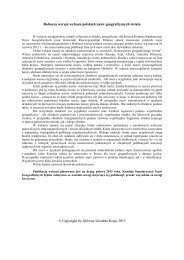
![Wykaz nazw miejscowości do mapy [plik pdf] - KSNG Nazwy ...](https://img.yumpu.com/51618887/1/184x260/wykaz-nazw-miejscowosci-do-mapy-plik-pdf-ksng-nazwy-.jpg?quality=85)

